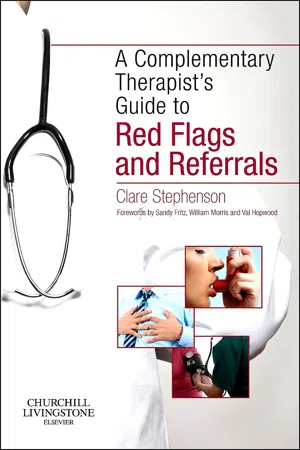
- 272 pages
- English
- ePUB (mobile friendly)
- Available on iOS & Android
The Complementary Therapist's Guide to Red Flags and Referrals
About This Book
Unique ready reference for all complementary medicine, massage
therapy and manual therapy practitioners and
students alerting them to 'red flag' symptoms
which should be referred for Western medical
investigation or emergency medical treatment.
When can a patient be safely reassured and when
do they need further investigation or treatment?
'Red flags' are clinical signs that suggest a patient
needs prompt investigation and treatment for
a potentially dangerous situation. Therapists
increasingly find themselves working alongside
conventionally trained doctors and nurses and it is
vital for them to understand conventional medical
diagnoses, symptoms and treatments and, crucially,
to recognise warning signs of serious disease. This
is essential in order to be a safe practitioner.
Clare Stephenson's The Complementary Therapist's
Guide to Red Flags and Referrals meets this need by
providing an easily accessible reference to 'red flag'
symptoms, designed especially for therapists. It offers
guidance on how best to respond to those symptoms
and signs of disease which can be readily discerned
through routine history taking and basic examination
of the body. The guidance is in language which is
accessible to therapists, and clear advice is offered
on when to refer patients to conventional medicine
practitioners and how to communicate with doctors
when making a referral.
Clinical syndromes which merit rapid response are
summarised for ease of reference.
Frequently asked questions
Information
Use of complementary medicine and red flags
The red flags as guides to referral

Prioritisation of the red flags
How to respond to the red flags
Non-Urgent Red Flags
High Priority Red Flags
Table of contents
- Cover image
- Title page
- Table of Contents
- Copyright
- Preface
- Foreword
- Foreword
- Foreword
- Acknowledgements
- Chapter 1: Red flags of disease
- Chapter 2: A tables: Red flags ordered by physiological system
- Chapter 3: B tables: Red flags ordered by symptom keyword
- Chapter 4: C tables: Red flags requiring urgent referral
- Chapter 5: Communicating with medical practitioners
- Chapter 6: Red flags and referrals: Ethical points
- Further reading
- Index